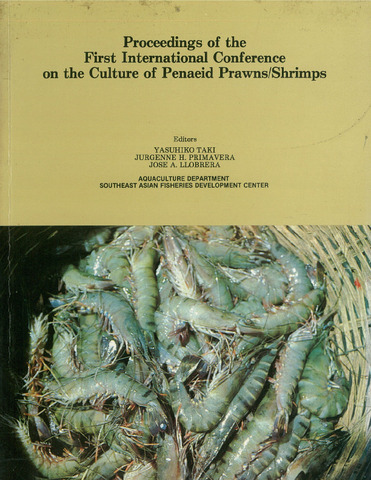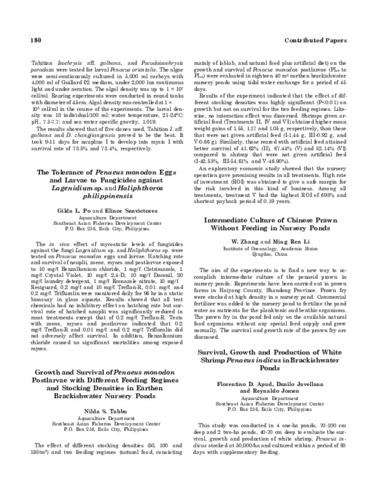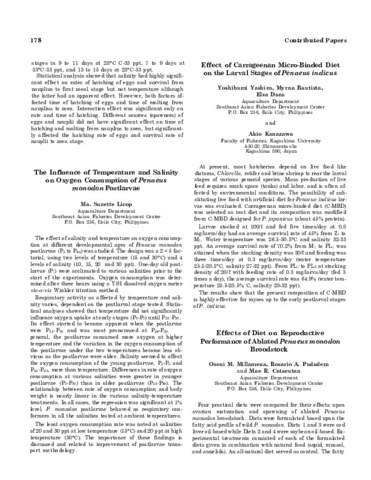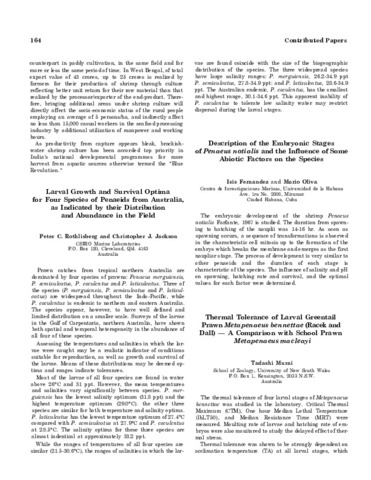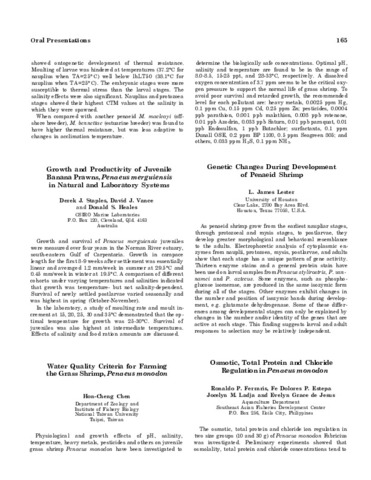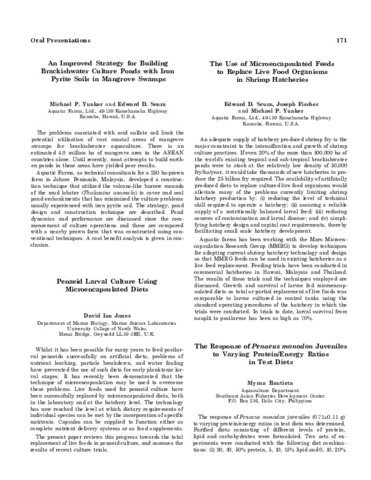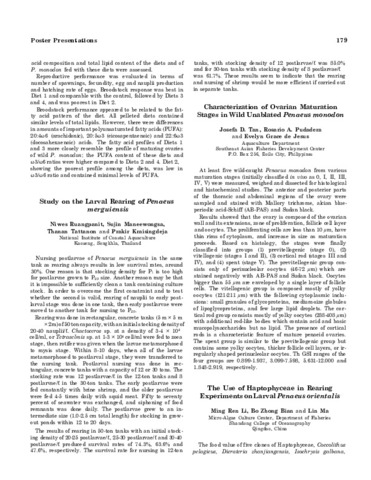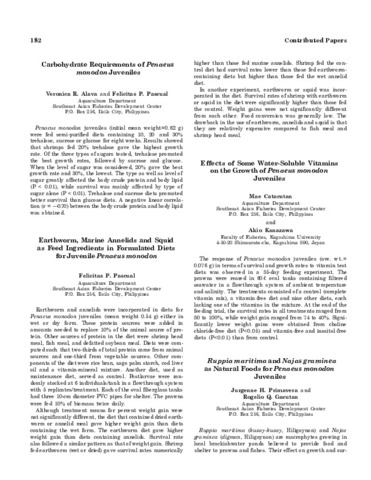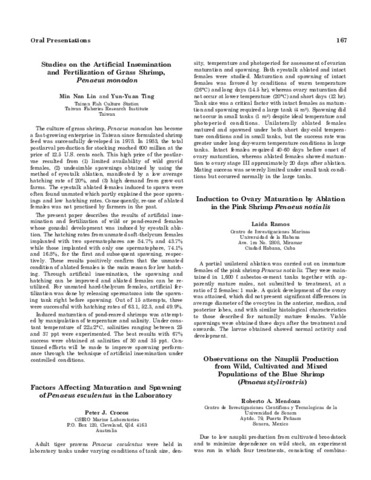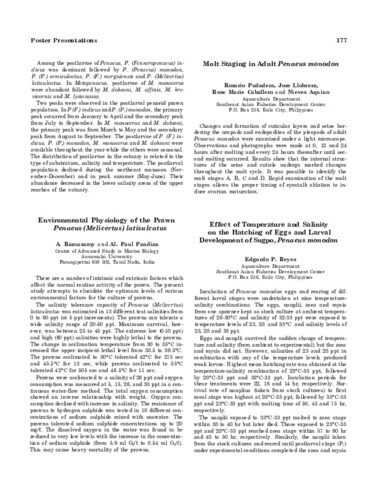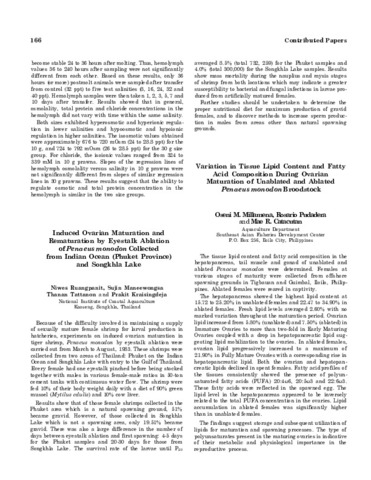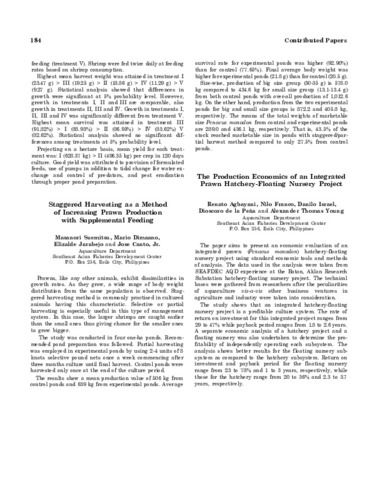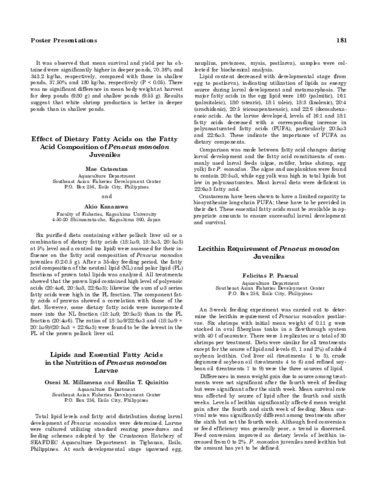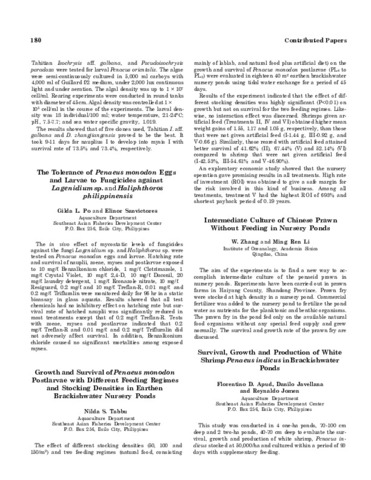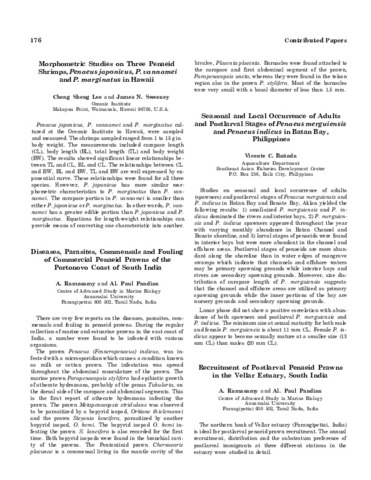公開日 のブラウズ: Proceedings of the First International Conference on the Culture of Penaeid Prawns/Shrimps
1-20 / 79
-
Culture of blue shrimp, Penaeus stylirostris in Sonora, Mexico
(Aquaculture Department, Southeast Asian Fisheries Development Center, 1985)The Centro de Investigaciones Cientificas y Tecnologicas de la Universidad de Sonora has been conducting research on the culture of the blue shrimp Penaeus stylirostris since 1972. Most of the programs carried out are ... -
Proceedings of the First International Conference on the Culture of Penaeid Prawns/Shrimps, Iloilo City, Philippines, 4-7 December 1984
(Aquaculture Department, Southeast Asian Fisheries Development Center, 1985)Abstracts of the 78 papers presented at the conference are cited individually. -
Survival, growth and production of white shrimp Penaeus indicus in brackishwater ponds
(Aquaculture Department, Southeast Asian Fisheries Development Center, 1985)This study was conducted in 4 one-ha ponds, 70-100 cm deep and 2 two-ha ponds, 40-70 cm deep to evaluate the survival, growth and production of white shrimp, Penaeus indicus stocked at 50,000/ha and cultured within a period ... -
Effects of diet on reproductive performance of ablated Penaeus monodon broodstock
(Aquaculture Department, Southeast Asian Fisheries Development Center, 1985)Four practical diets were compared for their effects upon ovarian maturation and spawning of ablated Penaeus monodon broodstock. Diets were formulated based upon the fatty acid profile of wild P. monodon. Diets 1 and 3 ... -
Larval growth and survival optima for four species of penaeids from Australia, as indicated by their distribution and abundance in the field
(Aquaculture Department, Southeast Asian Fisheries Development Center, 1985)Prawn catches from tropical northern Australia are dominated by four species of prawns: Penaeus merguiensis, P. semisulcatus, P. esculentus and P. latisulcatus. Three of the species (P. merguiensis, P. semisulcatus and P. ... -
Growth and productivity of juvenile banana prawns, Penaeus merguiensis in natural and laboratory systems
(Aquaculture Department, Southeast Asian Fisheries Development Center, 1985)Growth and survival of Penaeus merguiensis juveniles were measured over four years in the Norman River estuary, south-eastern Gulf of Carpentaria. Growth in carapace length for the first 8-9 weeks after settlement was ... -
The response of Penaeus monodon juveniles to varying protein/energy ratios in test diets
(Aquaculture Department, Southeast Asian Fisheries Development Center, 1985)The response of Penaeus monodon juveniles (0.71±0.11 g) to varying protein/energy ratios in test diets was determined. Purified diets consisting of different levels of protein, lipid and carbohydrates were formulated. Two ... -
Study on the larval rearing of Penaeus merguiensis
(Aquaculture Department, Southeast Asian Fisheries Development Center, 1985)Nursing postlarvae of Penaeus merguiensis in the same tank as rearing always results in low survival rates, around 30%. One reason is that stocking density for P1 is too high for postlarvae grown to P20 size. Another reason ... -
Carbohydrate requirements of Penaeus monodon juveniles
(Aquaculture Department, Southeast Asian Fisheries Development Center, 1985)Penaeus monodon juveniles (initial mean weight=0.62 g) were fed semi-purified diets containing 10, 20 and 30% trehalose, sucrose or glucose for eight weeks. Results showed that shrimps fed 20% trehalose gave the highest ... -
Factors affecting maturation and spawning of Penaeus esculentus in the laboratory
(Aquaculture Department, Southeast Asian Fisheries Development Center, 1985)Adult tiger prawns Penaeus esculentus were held in laboratory tanks under varying conditions of tank size, density, temperature and photoperiod for assessment of ovarian maturation and spawning. Both eyestalk ablated and ... -
Environmental physiology of the prawn Penaeus (melicertus) latisulcatus
(Aquaculture Department, Southeast Asian Fisheries Development Center, 1985)There are a number of intrinsic and extrinsic factors which affect the normal routine activity of the prawn. The present study attempts to elucidate the optimum levels of various environmental factors for the culture of ... -
The use of haptophyceae in rearing experiments on larval Penaeus orientalis
(Aquaculture Department, Southeast Asian Fisheries Development Center, 1985)The food value of five clones of Haptophyceae, Coccolithus pelagicus, Dicrateria zhanjiangensis, Isochrysis galbana, Tahitian Isochrysis aff. galbana, and Pseudoisochrysis paradoxa were tested for larval Penaeus orientalis. ... -
Variation in tissue lipid content and fatty acid composition during ovarian maturation of unablated and ablated Penaeus monodon broodstock
(Aquaculture Department, Southeast Asian Fisheries Development Center, 1985)The tissue lipid content and fatty acid composition in the hepatopancreas, tail muscle and gonad of unablated and ablated Penaeus monodon were determined. Females at various stages of maturity were collected from offshore ... -
Earthworm, marine annelids and squid as feed ingredients in formulated diets for juvenile Penaeus monodon
(Aquaculture Department, Southeast Asian Fisheries Development Center, 1985)Earthworm and annelids were incorporated in diets for Penaeus monodon juveniles (mean weight 0.54 g) either in wet or dry form. These protein sources were added in amounts needed to replace 10% of the animal source of ... -
Effects of some water-soluble vitamins on the growth of Penaeus monodon juveniles
(Aquaculture Department, Southeast Asian Fisheries Development Center, 1985)The response of Penaeus monodon juveniles (ave. wt.= 0.076 g) in terms of survival and growth rates to vitamin test diets was observed in a 35-day feeding experiment. The prawns were reared in 60-ℓ oval tanks containing ... -
Staggered harvesting as a method of increasing prawn production with supplemental feeding
(Aquaculture Department, Southeast Asian Fisheries Development Center, 1985)Prawns, like any other animals, exhibit dissimilarities in growth rates. As they grow, a wide range of body weight distribution from the same population is observed. Staggered harvesting method is commonly practised in ... -
Lipids and essential fatty acids in the nutrition of Penaeus monodon larvae
(Aquaculture Department, Southeast Asian Fisheries Development Center, 1985)Total lipid levels and fatty acid distribution during larval development of Penaeus monodon were determined. Larvae were cultured utilizing standard rearing procedures and feeding schemes adopted by the Crustacean Hatchery ... -
The tolerance of Penaeus monodon eggs and larvae to fungicides against Lagenidium sp. and Haliphthoros philippinensis
(Aquaculture Department, Southeast Asian Fisheries Development Center, 1985)The in vivo effect of mycostatic levels of fungicides against the fungi Lagenidium sp. and Haliphthoros sp. were tested on Penaeus monodon eggs and larvae. Hatching rate and survival of nauplii, zoeae, myses and postlarvae ... -
Diseases, parasites, commensals and fouling of commercial Penaeid prawns of the Portonovo coast of South India
(Aquaculture Department, Southeast Asian Fisheries Development Center, 1985)There are very few reports on the diseases, parasites, commensals and fouling in penaeid prawns. During the regular collection of marine and estuarine prawns in the east coast of India, a number were found to be infested ... -
Morphometric studies on three Penaeid shrimps, Penaeus japonicus, P. vannamei and P. marginatus in Hawaii
(Aquaculture Department, Southeast Asian Fisheries Development Center, 1985)Penaeus japonicus, P. vannamei and P. marginatus cultured at the Oceanic Institute in Hawaii, were sampled and measured. The shrimps sampled ranged from 1 to 15 g in body weight. The measurements included carapace length ...


